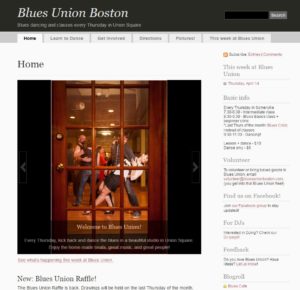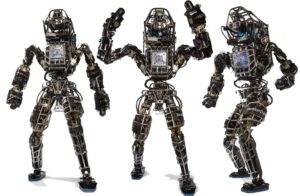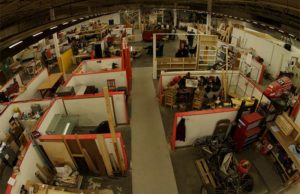Gui Cavalcanti

Gui Cavalcanti loves building giant robots, tuna robots (SCOPE), hexapod robots (Stompy via Kickstarter), challenge robots (Discovery Channel’s The Big Brain Theory), and also giant fighting MegaBots. Gui graduated from Olin in 2009 with a concentration in Robots (Duh), started Blues Union, Artisan’s Asylum, Hexapod and Megabots. He’s currently working on further developing Megabots with the intention of displaying at 2017 San Francisco World Maker’s Faire.
Gui’s Entrepreneurial Pursuits:
Megabots

“In the summer of 2015, MegaBots, inc. completed construction of the USA’s first giant piloted mech. The Mk. II MegaBot is a 15-foot tall, 12,000lb robot capable of hurling 3lb projectiles at speeds of over 130 MPH.
Upon completion of the Mk. II, MegaBots challenged the only other known giant piloted robot in the world to a duel. A 9,000lb robot known as KURATAS created by a group in Japan known as Suidobashi Heavy Industries.“
-Megabots website
Project Hexapod
Project Hexapod started with two other olin students. He funded project hexapod by giving classes on building robots: mechanical, electrical, and programming, at Artisan’s Asylum. Project Hexapod worked on the feasibility of the project during the beginning days. They eventually started a kickstarter and raised 100,000 dollars for the project to create an open-source, 18ft wide, 4,000 pound, 6-legged hydraulic robot that you can ride.
Artisan’s Asylum

Artisan’s Asylum started off in a 1000 square foot warehouse to store the shop tools he bought with his 40,000 dollar budget. The only way he could afford the rent and maintain the shop was to live there.
He contacted the people he worked with (Boston Dynamics, Blues Union), 100 people showed up wanting a membership on the kick off events. He needed more space, and a nearby makerspace approached with 9000 square foot space. He had 30 volunteer officers, included himself, that helped run the space. After a year working in Boston Dynamics, running the Asylum, and the Dancing Boston, he decided to be fully dedicated to Artisan’s Asylum.
However, the Asylum wasn’t making enough revenue to be more than an all consuming hobby. He took a step back, reexamined the business model: membership was stagnant, classes were at capacity, and rental studios had a 80 people long waiting list. He decided to increase the rental space that would allow more membership inflow. So, he bought more spaces in Somerville.
Gui bought the 25,000 square feet model, but realized that it wasn’t enough space. He bought more spaces around the area, for a total to 41,000 square feet. During this time, Molly Rubenstein came to help out starting the new warehouse. Eventually, after Artisan’s Asylum was up and running, he started to be tired of keeping the place running. He typically does this. “I wanted a thing to exist. I am now happy to step away once it exists.”
He found the opportunity to take a break from running artisan’s asylum. He went on the reality TV show “The Big Brain Theory” in which he worked in a machine shop doing different engineering challenges. During this time, Molly became the executive director for Artisan’s Asylum.
Blues Union

Dance studio in Union Square.
The Origin of Megabots – Present Day
Gui realizes building a giant mech is actually a possibility due to his background. For 2 years after Big brain theory, while teaching at Olin, had a set of personal projects involving hydraulics of a mech, example ammunition for mech, concept art for a giant mech. Spent $20,000 over two years just exploring this idea, but not planning to take it anywhere. Investor shows up to artisan’s asylum looking for projects to invest in. Instead of showing him the mech idea, Gui shows him a super efficient electric powered hydraulic power unit he built instead. Investor decides to invest and make a company out of it: Bigbots, a construction drone company. Took it to investors, and failed. Construction industry did not care, Bigbots was tackling one of the smallest costs that was not a huge problem, and the industry prefers having same tools that have been in place. Robot was not even built. After failure, Gui reveals his giant mech idea to same investor after having known him for four months. “Are you fucking serious?” was the response. But they went with it for the story. That is the beginning of the Megabots. Gui and his team built the Mk1, which was about half of the mech. First kickstarter to start sports league was treated as impossible. Autodesk came in, and invited them to Las Vegas to show their work. It goes really well. Worked out deal to work in San Francisco makerspace and make robot there. Eventually show it off at Maker Faire. Challenged the other mech in Japan. Create the other kickstarter campaign which was met with huge media hype. Very recently Megabots just got two million dollars in private investment.

Gui’s Time at Olin
Gui began his entrepreneurship journey at Olin in 2004, as a first year. “If there is a running theme to my entrepreneurship,” he said, “Its ‘I want to do a thing; it doesn’t exist; what the fuck? I am going to do this thing’, so I make it so I can do the thing”. Having participated in First Robotics during high school, Gui came to Olin excited about being able to develop his robotics skills and work in an applied robotics lab. However, upon arriving at Olin he discovered that the one lab on campus was unavailable. So, he decided to take on a year-long research project to develop and set up a new robotics lab under the supervision of Dave Barett. The summer after his first year, the lab was finally set up, so Gui, having made the space to be able to do the thing, started a robotics research project with Dave. During this time he also started taking blues and lindy hop lessons to occupy his extra time.
During his Sophomore year, Gui continued his work with robotics by pioneering the first ever POE project/Research project crossover: Working with Dave Barret and Gill Pratt, Gui and his team added research funding to a running POE project and built an actuating robotic snake. After this project concluded, Gui moved to Gil’s lab to help set it up for multiple small group projects over time, and became the lab manager of the biomimetic robotics lab. That summer, he pursued additional biomimetic robotics work through his internship with the MIT Locomotion Group, building Ornithopters for Ross Tedric.
“Junior Year”, Gui said, “Was the year I had a complete and utter nervous breakdown.” He had originally intended to take a leave of absence to participate in a design program in Italy, but at the last minute it fell through, and he was shoehorned into the room draw and class selection process. “I ended up taking all the terrible engineering classes that I had been putting off at the same time, while in a suite with a bunch of people that I hadn’t chosen that I found terribly uninteresting… it was miserable”. After the nightmarish fall semester, Gui’s self-esteem plummeted: “I had a lot of insecurity about my worth as an engineer: my grades that semester were the lowest I’d ever received in anything”. Frustrated, Gui decided to live off campus during spring semester, while he contemplated his choice of careers. He consulted his three chief advisors, Gil, Ben Linder, and Rob Martello, and expressed his frustration and lack of motivation to continue. “Rob was like “Fuck Yeah! You go do your thing! Tell me stories afterwards’,” he said, “But Gil and Ben just said ‘No. Sit your ass down, what are you doing? Stop it.” Gil suggested that Gui go and work as an engineer for a year, and helped Gui secure a year-long leave of absence to work at Boston Dynamics.
Gui described working at Boston Dynamics as “The single most reaffirming thing I’ve ever done”. “I had all these terrible grades,” he said, “But then I went to Boston Dynamics, solved major problems on [a system]…. And it was like ‘Ok, cool, I am a decent engineer, my grades are disconnected from the actual practice of engineering in a company, I can do this’.” After the spring semester spent at Boston Dynamics, he took a small break to work an internship program at BlueFin robotics. “It was basically UOCD for the real world” He said. “They asked us what we could do with a bunch of undersea robotics technology that wasn’t DoD related. It was great! We went out on boats with fishermen, and did all this cool stuff.” However, it wasn’t quite a dream come true: “At the end of the summer we compiled this huge report on all the things they could do, and BlueFin looked at it, said ‘yeah that’s cool’ and then just– Completely threw it away. ‘Nope, don’t need that’.” Of course, they later found out that the purpose of the program had been to pay a bunch of interns to play around with their tech, hoping to entice them to come and work for BlueFin full time. “But we wanted to feel useful, like we were solving a real problem,” he said of himself and the other interns, “and they didn’t do that for us.” So back to Boston Dynamics he went, to work on cool systems, until he came back for senior year.
Senior year was pretty normal for Gui, he took a reasonable number of classes and worked on SCOPE– for which he and his team created a robotic tuna. He had little to say on the SCOPE experience other than that it was perhaps…. Less than ideal? “But the project was cool, so whatever.” After graduating, Gui returned to Boston Dynamics to work full time as an engineer. During which time he became…. Incredibly bored. “It should tell you something about the experience that I worked at Boston Dynamics for a whole year, and I can’t tell you what I did.” he said. “At Olin, I can say ‘Oh yeah spring semester I did this and then fall I did this’, but I can’t tell you what I did at Boston Dynamics in April.”


“As a full time engineer, you don’t get to work with your hands… and I really missed that.” said Gui. “You get there, you’re given a computer with solidworks on it, you CAD your parts and send them off, and they come in. A tech unpacks and assembles your parts and if they’re fine– yay, then you’re done.” “Ironically,” he commented, “the only times you get to work in the machine shop is if you fuck your parts up, because you’re responsible for fixing them by your deadline.” Coming from Olin, where he had access to a machine shop that was open most of the time and all these great resources, Gui found that working at a 9-5 job truly bored him. It was at this time that he really started pursuing the dance scene (or lack thereof) in Boston and Cambridge.
Enter again the theme, “I want to do a thing, It doesn’t exist, I am going to make it exist, I will do this thing.” So he and his dance partner at the time started teaching blues lessons at MIT and Cambridge. After a while, people got really excited about it, he said, and they kept asking for a mailing list. So Gui and his partner set up a blues mailing list and several locations for lessons and social dances. However, they filled up way too fast, and eventually he just set up a weekly social dance.

